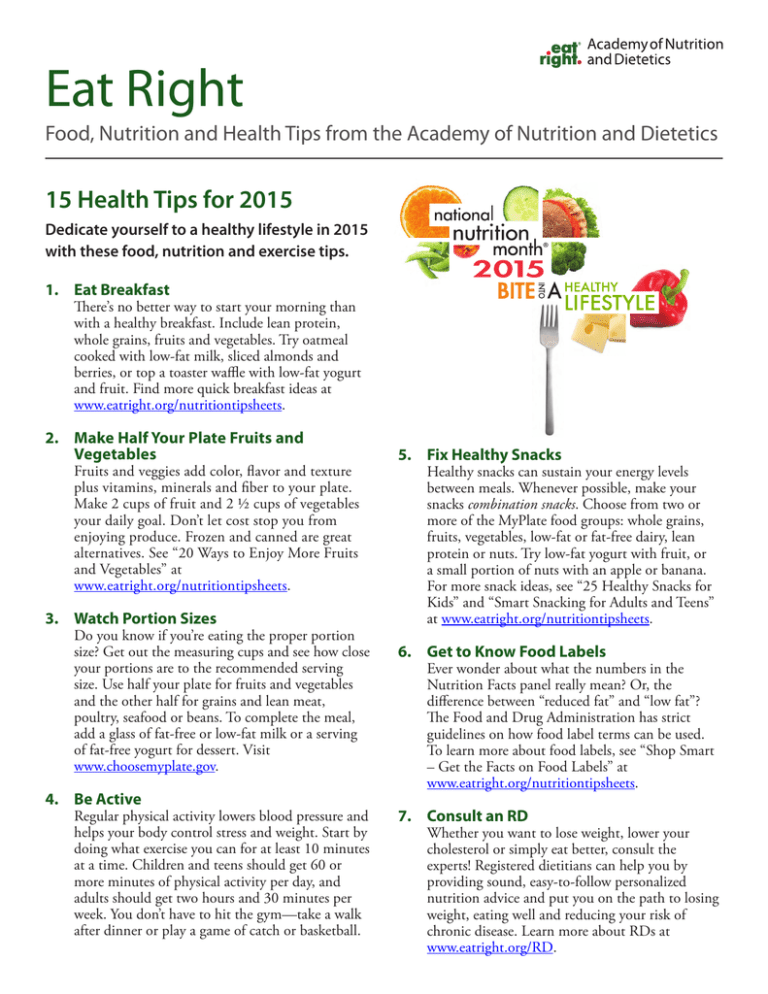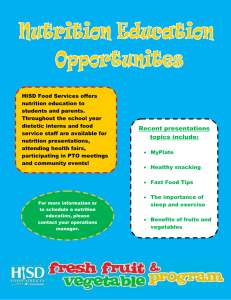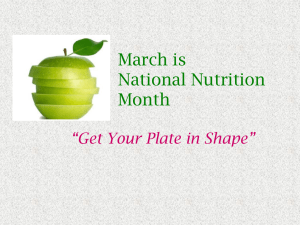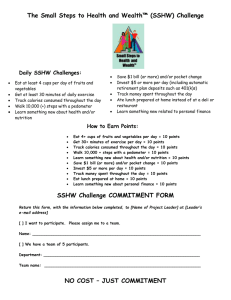March is National Nutrition Month®!
advertisement

Eat Right Food, Nutrition and Health Tips from the Academy of Nutrition and Dietetics 15 Health Tips for 2015 Dedicate yourself to a healthy lifestyle in 2015 with these food, nutrition and exercise tips. 1. Eat Breakfast There’s no better way to start your morning than with a healthy breakfast. Include lean protein, whole grains, fruits and vegetables. Try oatmeal cooked with low-fat milk, sliced almonds and berries, or top a toaster waffle with low-fat yogurt and fruit. Find more quick breakfast ideas at www.eatright.org/nutritiontipsheets. 2. Make Half Your Plate Fruits and Vegetables Fruits and veggies add color, flavor and texture plus vitamins, minerals and fiber to your plate. Make 2 cups of fruit and 2 ½ cups of vegetables your daily goal. Don’t let cost stop you from enjoying produce. Frozen and canned are great alternatives. See “20 Ways to Enjoy More Fruits and Vegetables” at www.eatright.org/nutritiontipsheets. 3. Watch Portion Sizes Do you know if you’re eating the proper portion size? Get out the measuring cups and see how close your portions are to the recommended serving size. Use half your plate for fruits and vegetables and the other half for grains and lean meat, poultry, seafood or beans. To complete the meal, add a glass of fat-free or low-fat milk or a serving of fat-free yogurt for dessert. Visit www.choosemyplate.gov. 4. Be Active Regular physical activity lowers blood pressure and helps your body control stress and weight. Start by doing what exercise you can for at least 10 minutes at a time. Children and teens should get 60 or more minutes of physical activity per day, and adults should get two hours and 30 minutes per week. You don’t have to hit the gym—take a walk after dinner or play a game of catch or basketball. 5. Fix Healthy Snacks Healthy snacks can sustain your energy levels between meals. Whenever possible, make your snacks combination snacks. Choose from two or more of the MyPlate food groups: whole grains, fruits, vegetables, low-fat or fat-free dairy, lean protein or nuts. Try low-fat yogurt with fruit, or a small portion of nuts with an apple or banana. For more snack ideas, see “25 Healthy Snacks for Kids” and “Smart Snacking for Adults and Teens” at www.eatright.org/nutritiontipsheets. 6. Get to Know Food Labels Ever wonder about what the numbers in the Nutrition Facts panel really mean? Or, the difference between “reduced fat” and “low fat”? The Food and Drug Administration has strict guidelines on how food label terms can be used. To learn more about food labels, see “Shop Smart – Get the Facts on Food Labels” at www.eatright.org/nutritiontipsheets. 7. Consult an RD Whether you want to lose weight, lower your cholesterol or simply eat better, consult the experts! Registered dietitians can help you by providing sound, easy-to-follow personalized nutrition advice and put you on the path to losing weight, eating well and reducing your risk of chronic disease. Learn more about RDs at www.eatright.org/RD. 8. Follow Food Safety Guidelines The Centers for Disease Control and Prevention estimates that roughly one in six Americans gets sick from foodborne disease each year. Reduce your chances of getting sick by practicing proper hand washing. Separate raw meat, poultry and seafood from ready-to-eat foods like bread and vegetables. Use a food thermometer to make sure food is properly cooked. Refrigerate food quickly at a proper temperature to slow bacteria growth. Learn more about home food safety at http://homefoodsafety.org. 9. Get Cooking Cooking at home can be healthy, rewarding and cost-effective. Resolve to learn some cooking and kitchen basics, like how to dice an onion or how to store herbs and spices. The collection of How do I… videos at www.eatright.org/howdoi will get you started. 10. Dine Out without Ditching Your Goals You can dine at a restaurant and stick to your healthy eating plan! The key is to plan ahead, ask questions and choose foods carefully. Think about nutritious items you can add to your plate—fruits, veggies, lean meat, poultry or fish—and look for grilled, baked, broiled or steamed items. See “Healthy Eating on the Run” at www.eatright.org/nutritiontipsheets. 11. Enact Family Meal Time Research shows that family meals promote healthier eating. Plan to eat as a family at least a few times each week in 2015. Set a regular mealtime. Turn off the TV, phones and other electronic devices to encourage mealtime talk. Get kids involved in meal planning and cooking and use this time to teach them about good nutrition. For more family mealtime tips, visit www.kidseatright.org. salsa; or spinach salad with sliced pear, red onion and low-fat feta cheese. Keep lunches safe with tips from http://homefoodsafety.org. 13. Drink More Water Drink water instead of sugary drinks and let thirst be your guide. A healthy body can balance water needs throughout the day. Drink plenty of water if you are active, live or work in hot conditions, or are an older adult. 14. Explore New Foods and Flavors Add more nutrition and eating pleasure by expanding your range of food choices. When shopping, make a point of selecting a fruit, vegetable or whole grain that’s new to you or your family. Try different versions of familiar foods like blue potatoes, red leaf lettuce or basmati rice. 15. Eat Seafood Twice a Week Seafood—fish and shellfish—contains a range of nutrients including healthy omega-3 fats. Salmon, trout, oysters and sardines are higher in omega-3s and lower in mercury. For a referral to a registered dietitian nutritionist and for additional food and nutrition information visit www.eatright.org. 12. Banish Brown Bag Boredom Whether it’s a brown bag lunch for work or school, make it a healthy lunch packed with nutrition. Prevent brown bag boredom with easy-to-fix, healthy lunch ideas. Try whole-wheat couscous with chick peas; whole-wheat tortilla filled with chicken, mushrooms, onions and tomatoes; baked potato topped with broccoli, low-fat cheese and This tip sheet is provided by: Adapted from the article “13 Health Tips for 2013” (www.eatright.org/Public/content.aspx?id=6442474069) by Academy of Nutrition and Dietetics staff registered dietitian nutritionists. ©2015 Academy of Nutrition and Dietetics. Reproduction of this tip sheet is permitted for educational purposes. Reproduction for sales purposes is not authorized.



